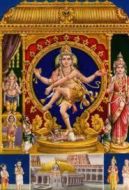Description
Thillai Natarajah Temple, Chidambaram or Chidambaram temple is a Hindu temple dedicated to Lord Shiva located in the town of Chidambaram, East-Central Tamil Nadu, South India. The temple is known as the foremost of all temples (Kovil) to Saivites and has influenced worship, architecture, sculpture and performance art for over two millennium. The Sangam classics list chief architect Viduvelvidugu Perumtaccan as directing an early renovation of the shrine.
History
A major shrine of Lord Shiva worship since the classical period, there have been several renovations and offerings to Chidambaram by the Pallava, Chola, Pandya, Vijayanagara and Chera royals in the ancient and pre-medieval periods. The temple as it stands now is mainly of the 12th and 13th centuries, with later additions in similar style. Its bronze statues and stone sculptures depicting various deities and the famous Thillai trees (Excoecaria agallocha) of the surrounding forest reflect the highpoints of early Chola and Pallava art while its famed gold plated gopuram towers are medieval structural additions by the royals Aditya I, Parantaka Chola I, Kopperunchinga I, Krishnadevaraya and Jatavarman Sundara Pandyan. King Kocengannan Chola was born following prayers his parents offered at the temple and later in his life he refined its structure. The shrine gave the town its name.
Importance/Significance
The deity that presides here is Thillai Koothan (Thillai Nataraja - Shiva, The Lord of Dance). Chidambaram is the birthplace of the sculpture and bronze image representation of Lord Shiva as the cosmic dancer, a Tamilian concept and motif in Chola art that has since become notable as a symbol of Hinduism. The shrine is the only Shiva temple to have its main deity represented in this anthropomorphic form, as the supreme being who performs all cosmic activities. The consort deity here is Sivakami Amman (form of Amman - mother goddess and female energy). Two other forms of Lord Shiva are represented close to this in the vimana (inner sanctum) of the temple - as a crystallised lingam - the most common representation of Lord Shiva in temples, and as the aether space classical element, represented with empty space and a garland of fifty one hanging golden vilvam leaves (Aegle marmelos). Lord Shiva is captured in pose as Nataraja performing the Ananda Tandava ("Dance of Delight") in the golden hall of the shrine Pon Ambalam. The sculptures of Chidambaram inspired the postures of Bharatha Natyam
Facts/Mythology
The story of Chidambaram begins with Lord Shiva strolling into the Thillai. In the Thillai forests resided a group of sages or 'rishis' who believed in the supremacy of magic and that God can be controlled by rituals and mantras or magical words.Lord Shiva strolled in the forest with resplendent beauty and brilliance, assuming the form of Bhikshatana, a simple mendicant seeking alms. He was followed by His consort, Vishnu as Mohini. The sages and their wives were enchanted by the brilliance and the beauty of the handsome mendicant and His consort. On seeing their womenfolk enchanted, the rishis got enraged and invoked scores of serpents (nāgas) by performing magical rituals. Lord Shiva lifted the serpents and donned them as ornaments on His matted locks, neck and waist. Further enraged, the sages invoked a fierce tiger, whose skins and dons were used by Lord Shiva as a shawl around His waist and then followed by a fierce elephant, which was devoured and ripped to death by Lord Shiva.
The rishis gathered all their spiritual strength and invoked a powerful demon Muyalakan - a symbol of complete arrogance and ignorance. Lord Shiva wore a gentle smile, stepped on the demon's back, immobilized him and performed the Ánanda Tandava (the dance of eternal bliss) and disclosed his true form. The sages surrender, realizing that Lord Shiva is the truth and He is beyond magic and rituals.
Festivals/Events/Gatherings

